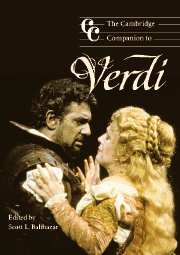Book contents
- Frontmatter
- Part I Personal, cultural, and political context
- Part II The style of Verdi's operas and non-operatic works
- 4 The forms of set pieces
- 5 Newcurrents in the libretto
- 6 Words and music
- 7 French influences
- 8 Structural coherence
- 9 Instrumental music in Verdi's operas
- 10 Verdi's non-operatic works
- Part III Representative operas
- Part IV Creation and critical reception
- Notes
- List of Verdi's works
- Select bibliography and works cited
- Index
5 - Newcurrents in the libretto
from Part II - The style of Verdi's operas and non-operatic works
Published online by Cambridge University Press: 28 September 2011
- Frontmatter
- Part I Personal, cultural, and political context
- Part II The style of Verdi's operas and non-operatic works
- 4 The forms of set pieces
- 5 Newcurrents in the libretto
- 6 Words and music
- 7 French influences
- 8 Structural coherence
- 9 Instrumental music in Verdi's operas
- 10 Verdi's non-operatic works
- Part III Representative operas
- Part IV Creation and critical reception
- Notes
- List of Verdi's works
- Select bibliography and works cited
- Index
Summary
From the beginning, the libretto (“little book” because of its small printed format) played a fundamental role in operatic structure and style. Until the mid-eighteenth century, a dramma permusica was considered a literary text, judged according to the canons of spoken theatre. It led an autonomous life, and its music constituted an aspect of staging, one that could change over time. By the nineteenth century, however, this relationship was inverted: the music became more important, and composers intervened in writing the libretto, assuming the role of “musical dramatists.” This trend culminated in Germany with Wagner and in Italy with Verdi, who did not write his own librettos but influenced their genesis profoundly. Through this reversal, nineteenth-century librettos lost importance as a literary genre. They were compared unfavorably to their literary sources (especially when these were the greatest examples of dramatic literature by Shakespeare, Schiller, and others) and criticized for unrealistic plots and purportedly bombastic, antiquated language. In the last thirty years, however, literary critics as well as musicologists and those in theatre studies have recognized the nonliterary values of the libretto and have reappraised its function in musical dramaturgy.
In considering Verdi's librettos, it is useful to distinguish between dramatic, poetic, and literary design. The fact that Verdi intervened in the first category most and the third least implies that they should be considered as being of decreasing importance.
- Type
- Chapter
- Information
- The Cambridge Companion to Verdi , pp. 69 - 87Publisher: Cambridge University PressPrint publication year: 2004
- 1
- Cited by

